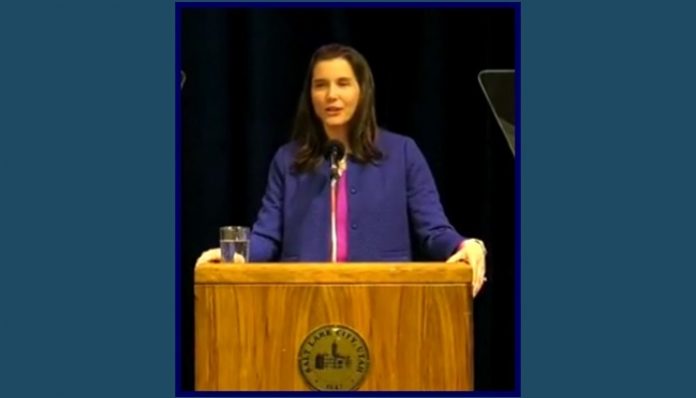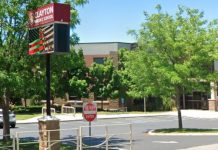SALT LAKE CITY, Utah, May 27, 2021 (Gephardt Daily) — Salt Lake City Mayor Erin Mendenhall on Thursday declared a Stage 2 water shortage contingency response for Salt Lake City and Salt Lake County water customers.
The declaration was triggered by “dramatically low mountain snow melt and stream flows,” according to the mayor. The creeks that supply a portion of the water for more than 360,000 water customers are ranging from only 22 percent to 52 percent of average this year.
“All indicators point to a severe drought in the coming months in Salt Lake City and across our state,” said Mendenhall. “Relying on data and advice from our water supply experts, we will increase our conservation efforts from an earlier Stage 1 to Stage 2 of our City Water Shortage Contingency Plan.”
Stage 1 was enacted on March 24 as a fully voluntary advisory, Mendenhall said. In Stage 2, most actions remain voluntary, except greater conservation responsibilities fall on municipal and other government facilities. Government facilities throughout Salt Lake City’s service area are required to stay within established watering budgets and to implement specific best practices to reduce water use and water waste.
As in Stage 1, Salt Lake City Department of Public Utilities will continue to inform the public of water supply conditions and to increase public education about water conservation. The goal is to save enough water early on to prevent more stringent responses. The Water Shortage Contingency Plan outlines five water shortage stages triggered by supply levels, stream flows, and water demand; it also provides recommendations for actions within each stage aimed at reducing water demand to levels that reflect current supply and future water needs.
The plan authorizes the SLCDPU Director to recommend contingency stages based on continued conditions and water supply measurements.
“Our snowpack, stream flow, and reservoir storage are exceedingly low,” said SLCDPU Director Laura Briefer. “Less precipitation means our soil moisture is also exceptionally low. The U.S. Department of Agriculture indicates that most of Salt Lake County is in ‘exceptional drought’ and drought in our region is anticipated to be persistent through the coming months. As the summer watering season progresses, we want to be proactive and timely in our response.”
Stage 2 conservation objectives include:
- Managing water use and reducing water use at municipal facilities and other institutional properties.
- Coordination with government agencies and school districts with properties within the Public Utilities service area to take actions that reduce water use.
- Managing water supply conservatively enough to avoid or minimize the need for later, more stringent actions.
- Minimizing water waste through carelessness — either intentional or accidental.
City departments and divisions will reduce outdoor watering and will test equipment for maximum watering efficiency as dry conditions continue. The Salt Lake City Fire Department will conduct only “dry” fire hydrant inspections this summer to assess proper working order for fire flows, rather than opening hydrants.
The city’s Department of Public Services will actively monitor water use in managed parks and facilities, and stay within watering budgets, said Director Lorna Vogt. Residents are encouraged to report broken sprinkler and irrigation systems they may see in city parks and on building grounds via the SLC Mobile app.
Mendenhall continues to encourage all residents and businesses to monitor indoor and outdoor water use and to conserve in every way possible. “Time and again, we in Salt Lake City prove how much we can accomplish when we work together toward a common good,” she said. “I am asking everyone to use the water you need, but with purpose and respect for a precious and limited natural resource. We can do this.”
Due to extreme drought conditions in 90 percent of Utah, Gov. Spencer J. Cox issued an Executive Order on March 17 declaring a state of emergency. He has continued to urge statewide conservation and to increase wildfire awareness and prevention in the tinder-dry state.
The last time Salt Lake City declared a Stage 2 response was in 2004, and a Stage 3 response was triggered later that summer. City parks and golf courses were required to cut water use by 15 percent, fund-raising car washes were prohibited, and city water fountains were shut off.
Taking simple conservation measures now may help prevent the need for moving to a more restrictive stage of the Water Shortage Contingency Plan:
- Sign up for a free water check from Utah State University Extension. This will help you determine efficient watering levels for your lawn and landscapes.
- Adjust automatic sprinkler controllers to reflect the season and weather, including shutting off during rainstorms.
- Check sprinkler systems for broken or misaligned spray heads.
- Water lawns sparingly in evening and early morning only; lawn will typically go dormant in summer and reducing water will not kill it
- Check indoor faucets and fixtures for leaks and repair promptly. Find helpful tips here.






